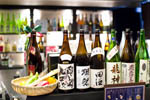Sake tableware
With Japanese food, the tableware on which the food is served is intrinsic to the overall experience. The colors of the ceramics (white, blue, red, green, black, brown, and any number of combinations and textures) complement the visual pleasure and flavors of the meal. The same is true for tokkuri, the thin-necked flasks in which the liquid is served, and sake cups. Each comes in a variety of shapes and sizes and can be acquired for the equivalent of a few dollars, or hundreds, sometimes thousands of dollars. Both top-flight artists and artisans turn out designs. Craftspeople working in ceramics, lacquer ware, bamboo, glass and wood release works that are eagerly consumed by a discriminating public.
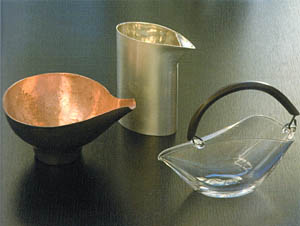
Katakuchi: These open-mouthed decanters come in a wide range of shapes, and are a lovely, elegant way to serve sake. Also excellent for giving sake some air, or gently warming up sake that is overchilled.
Sake cups
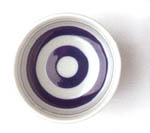
Sake cups are called guinomi, sakazuki, or choko (this last is commonly used in the honorific form, o-choko). Choko and sakazuki refer to small cups, guinomi to larger chugging cups. Very tiny cups seem impractical unless you realize they are part of the congenial ritual of o-shaku - pouring for one's drinking companion. They are small precisely so that you get to pour more often.
The small size of many sake cups means that there is little head space to swirl the liquid in wine-tasters' fashion. If you want to swirl, a tulip-shaped glass will emphasize the fragance of that fruity ginjo you bought. For earthier styles, a flatter, oval-shaped glass is better. Specialist wine glasses designed to enhance the characteristics of specific grape varieties can have a startling effect on the quiter sake aromatics. However, should you switch to wine glasses, remember that most sake is more potent than wine. Don't fall into the trap of drinking the same amount as you would were you drinking wine, just because you are drinking from a wine glass, or you could end up with more than you bargained for.
Flasks
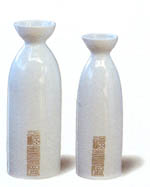
Tokkuri are the little thin-necked decanters used to hold, heat, and pour sake - the thin neck is designed to retain heat. Most hold one or two go, one-tenth or two-tenths of a large bottle of sake, respectively. Each go is 6 fluid ounces (180 milliliters). Ceramic and pewter decanters are used when warming sake, and often come in sets with matching choko. A wide, open-mouthed receptacle called a katakuchi is sometimes used to serve sake cold or at room temperature, and these may be made of ceramic or glass. Wooden tokkuri impart a light scent of wood to the sake.
Materials
Ceramics
The history of Japanese ceramics goes back over twelve thousand years. The many schools of Japanese pottery arose as expressions of geology (the clay of a particular region) and local culture - from the poignant simplicity of pots from Tanba, which were originally everyday receptacles made by the area's farmers, to the refinement of Raku ware, inextricably bound to the high culture of tea ceremony. The sorcerous metamorphosis of the raw materials into expressions as various as shell-like porcelain and the earthy, ashy wonders of the wood-fired Bizen or Shigaraki ceramic ware is an intriguing parallel to the range of transformations that Japan's brewers conjure with rice. The nursery that resulted in such glorious variety in ceramics is the same that nurtured sake, so that drinking sake from Japanese ceramics has a reinforcing effect, amplifying the pleasure of the experience.
There are few activities as pleasant as deciding which sake to drink; choosing the cup is one of them. I find that a crystalline dai ginjo calls out for a delicate cup, and earthy, ricey sake is best sipped from a guinomi with plenty of what potters call tsuchi-aji, or an earthy feel. A thick, round-lipped cup delivers the liquid to your palate in a way that is different from that of a wafer-thin edge, and the difference affects the way a sake tastes.
Wood
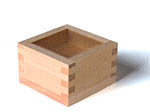
The humble masu, a square box made of sugi (Japanese cedar), is one of the most familiar of sake-related images. Sake commonly used to be served in a masu, but its use nowadays is restricted mainly to high days and holidays - festivals and weddings in particular. The masu used at such events are new, and the powerful scent of the wood may overshadow that of the sake itself. Drink from the corner to avoid embarrassing dribbles.
Many izakaya drinking establishments serve sake in glasses placed inside masu. This catches any spills, and allows the owner to please favored regular customers by overfilling the glass so that the extra sake is caught in the masu.
You may come across wooden choko or guinomi, for which the most commonly used wood is Japanese cedar.
Lacquer
When visitors from the West discovered the elegant, lustrous products of the perilous craft of coating wood with multiple coats of the poisonous sap of the urushi (lacquer) tree, they called it japanning. You may have seen victorious sumo wrestlers drinking from enormous sake cups, closer in dimension to washbasins than toothbrush mugs. These great lacquer receptacles, holding from a measly five go (30 fluid ounces/900 milliliters) to three sho (5.7 quarts/5.4 liters), became popular in the Kamakura period (1185-1333). The warrior elite of the time passed these around at drinking parties dignified with the grand name of sakazukigoto. However, since to pass a pottery cup of this size around a group of increasingly inebriated warlords would be asking for trouble because of the cup's weight, feather-light, lacquer-ware cups were chosen, although they are delicate in their own way and require careful storage.
Glass and Metal
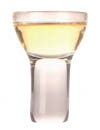
Pewter tankards and pottery steins aside, it is fairly unusual in the West to drink alcohol from anything but glass. Yet, in Japan, glass vessels for drinking are a newfangled idea, having made their appearance in the nineteenth century, and having gained real popularity still more recently. Although wine glasses are sometimes used, it is more fun to use glass choko, which come in all shapes and sizes. Cold sake is great in glass cups.
Sake cups made of metal (mainly pewter) do exist, but are rather rare.
More about sake
Source Notes
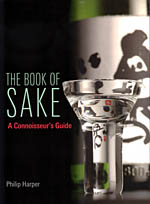
Reprinted with permission from the book:
The Book of Sake: A Connoisseur's Guide
Kodansha International
Once found only in sushi bars and Japanese restaurants outside its native land, sake now lines the shelves of our gourmet food shops, liquor stores, supermarkets, and restaurants of all types. And as sake increasingly becomes a part of the way we dine and entertain, people everywhere are looking for guidance in sorting out the confusing and intimidating array of choices available.
In The Book of Sake, brew master Philip Harper provides all the information anyone needs to discover the many pleasures of Japan's national tipple. Harper also introduces tidbits of sake lore (as only an insider can), a groundbreaking new tasting chart, and a selection of sakes for all palates and pocketbooks by the esteemed sake journalist Haruo Matsuzaki.
ISBN4-7700-2998-0
- Order this book from amazon.com
- Order this book from amazon.co.jp (in Japan)
- Find this book at your local English-language bookstore in Japan
- Or use the ISBN to order from your local bookstore.
More about sake
- © Copyright Lobster Enterprises
- Privacy
- Bento.com top
- © Copyright Lobster Enterprises
- Privacy
- Bento.com top
- © Copyright Lobster Enterprises
- Privacy
- Bento.com top








